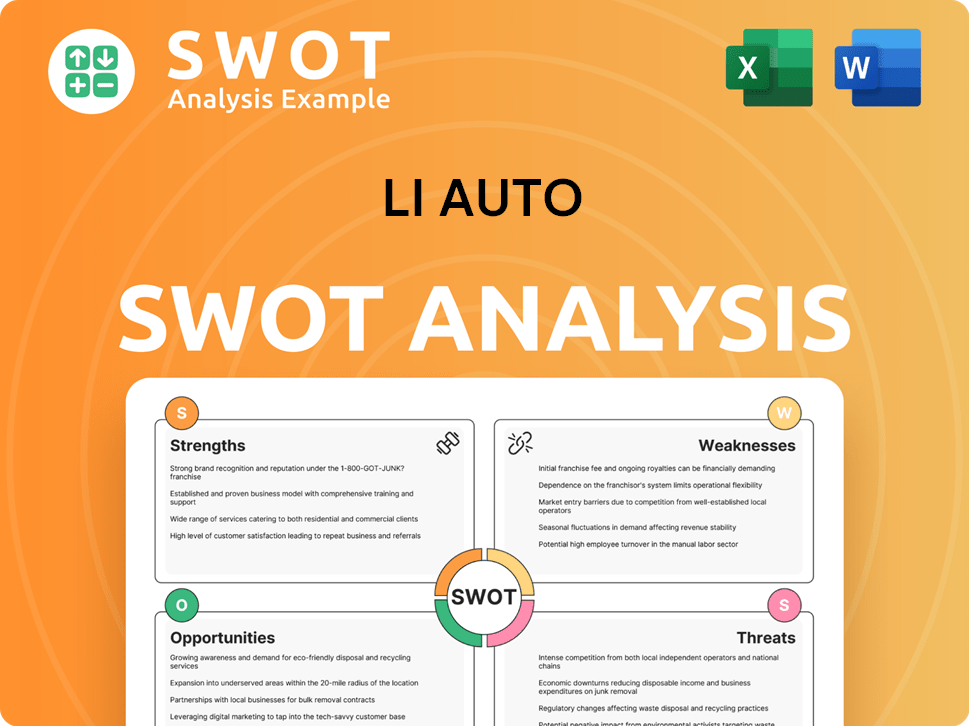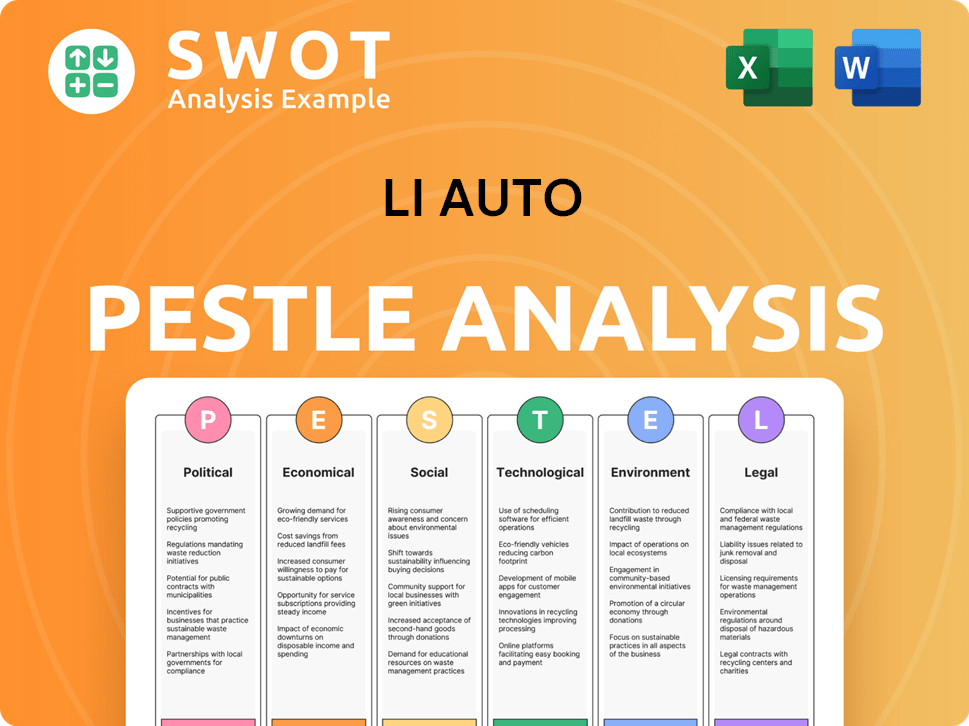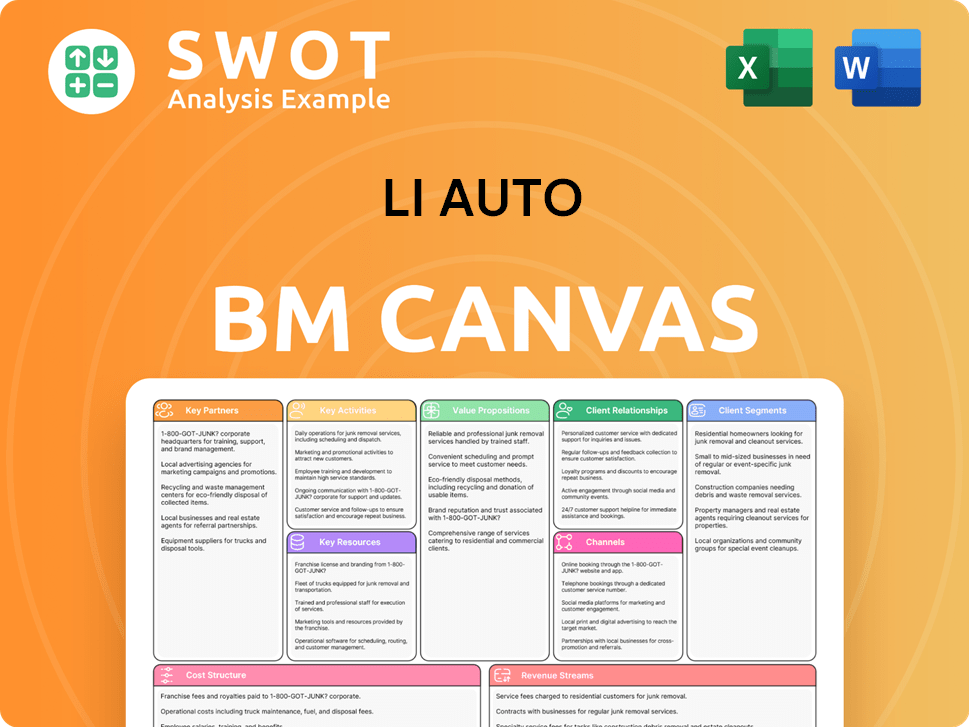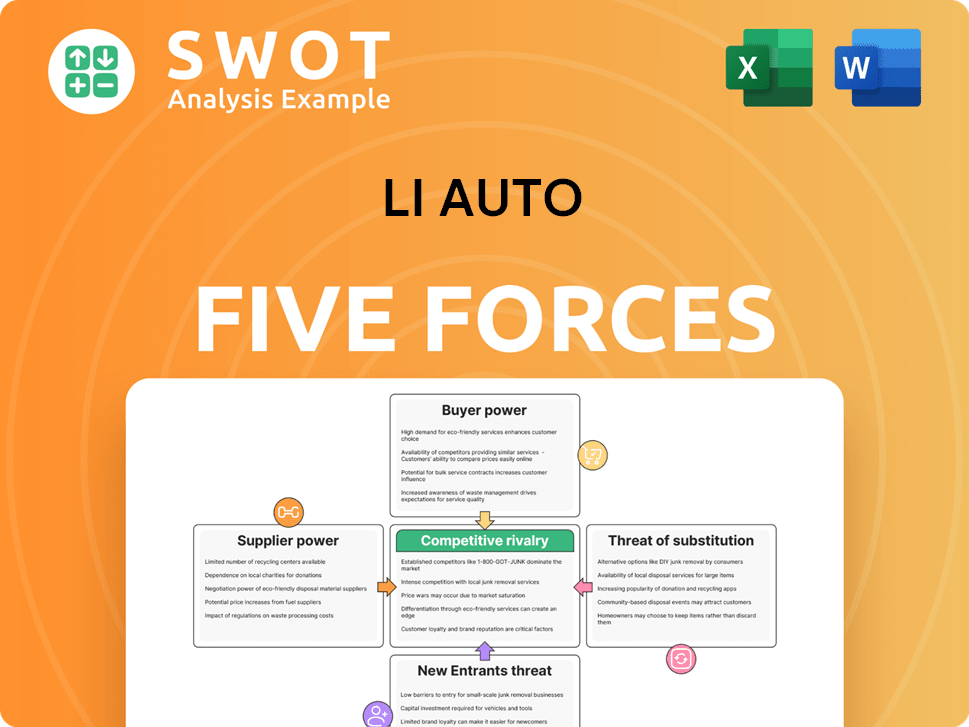Li Auto Bundle
How Has Li Auto Mastered the EV Market Through Sales & Marketing?
Li Auto's journey in the competitive electric vehicle (EV) market, particularly in China, is a masterclass in strategic execution. The launch of the Li MEGA MPV in March 2024 marked a significant expansion beyond its SUV focus, showcasing the company's ambition. This, coupled with its EREV (extended-range electric vehicle) strategy, has been key to its success. Founded in 2015, Li Auto's initial vision of family-oriented smart EVs has shaped its Li Auto SWOT Analysis and go-to-market approach.

This exploration delves into Li Auto's innovative sales channels, from its direct-to-consumer model to its evolving omnichannel approach, and the marketing tactics that have fueled its brand recognition. We'll analyze how Li Auto strategically positions its brand to resonate with its target audience and examine impactful marketing campaigns. Understanding the Li Auto sales strategy, including its customer acquisition strategy, is crucial for investors and business strategists alike, especially when considering the Li Auto electric vehicle sales and overall Li Auto market analysis.
How Does Li Auto Reach Its Customers?
The sales and marketing strategy of Li Auto centers around a direct-to-consumer (DTC) model, a key element of its approach. This strategy integrates both online and offline channels, aiming for extensive customer reach. This comprehensive approach allows for a seamless customer experience, from initial interest to the final purchase.
Li Auto's strategy emphasizes a digital-first approach, utilizing its website and mobile app for vehicle configuration, pre-orders, and direct sales. This focus provides convenience and a smooth purchasing experience for tech-savvy consumers. The company's expansion into physical retail locations further strengthens its market presence.
As of March 31, 2024, Li Auto had a significant retail presence with 474 retail stores across 142 cities in China. These stores are strategically located to provide potential customers with firsthand vehicle experiences and sales interactions. This growth reflects an omnichannel integration, balancing digital convenience with physical interaction in the high-consideration purchase of an automobile.
Li Auto's official website and mobile application are the primary online platforms for sales. Customers can configure vehicles, place pre-orders, and complete direct purchases. This digital-first approach streamlines the buying process for consumers.
The company operates a network of retail stores strategically located in high-traffic areas. These stores allow potential customers to experience vehicles firsthand and engage with sales representatives. Service centers also support sales through after-sales service and customer engagement.
Li Auto has rapidly expanded its sales and service network. By the end of 2023, the network included 467 stores in 140 cities, up from 288 stores in 124 cities at the end of 2022. This expansion has been crucial for Li Auto's growth and market share.
As of March 31, 2024, Li Auto had 357 service centers across 209 cities. These centers support sales through after-sales service and customer engagement. The strategic placement of service centers enhances the overall customer experience.
While primarily focused on its DTC model, Li Auto explores partnerships to enhance the customer ecosystem, particularly for charging solutions and service networks. This approach aims to improve customer satisfaction and expand market reach. Understanding the Target Market of Li Auto is crucial for effective sales and marketing efforts.
- DTC model integrates online and offline channels.
- Rapid expansion of retail stores and service centers.
- Focus on customer experience through strategic locations.
- Partnerships to enhance charging solutions and service networks.
Li Auto SWOT Analysis
- Complete SWOT Breakdown
- Fully Customizable
- Editable in Excel & Word
- Professional Formatting
- Investor-Ready Format

What Marketing Tactics Does Li Auto Use?
The marketing tactics of Li Auto are designed to boost brand awareness, generate leads, and drive sales. The company employs a blend of digital and traditional strategies to reach its target audience. This approach is crucial for success in the competitive electric vehicle (EV) market.
Li Auto's marketing strategy focuses on a strong online presence complemented by strategic offline engagements. A key element is community building around its products. This multi-faceted approach helps the company connect with potential customers and build brand loyalty.
The company's marketing mix has evolved to emphasize a strong online presence complemented by strategic offline engagements, with a notable focus on community building around its products. This approach is crucial for success in the competitive electric vehicle (EV) market, as highlighted in a recent analysis of the Growth Strategy of Li Auto.
Li Auto uses content marketing, SEO, and paid advertising across digital channels. Email marketing is also employed for lead nurturing. Social media platforms like Weibo, WeChat, and Douyin are heavily utilized.
The company actively engages with its audience on platforms like Weibo, WeChat, and Douyin. They showcase vehicle functionalities and run interactive campaigns. This helps build a strong online community.
Li Auto partners with automotive reviewers and tech enthusiasts. This leverages their reach and credibility. These partnerships are a key component of their digital strategy.
The company participates in major auto shows and industry events. This allows for direct interaction with potential customers. Showcasing new models is a key aspect.
Li Auto analyzes customer behavior and preferences to refine targeting. They personalize marketing messages. This approach uses sophisticated CRM and marketing automation systems.
The marketing mix emphasizes a strong online presence. It is complemented by strategic offline engagements. Community building around products is also a focus.
Li Auto's marketing strategy is designed to drive Li Auto electric vehicle sales and enhance Li Auto brand positioning. The company focuses on a multi-channel approach to engage with potential customers and build brand loyalty. This approach includes a strong emphasis on digital marketing, influencer partnerships, and offline events.
- Digital Marketing: Content marketing, SEO, paid advertising, and email marketing are crucial for lead generation and brand awareness.
- Social Media: Platforms like Weibo, WeChat, and Douyin are used to engage with the audience and showcase vehicle features.
- Influencer Partnerships: Collaborations with automotive reviewers and tech enthusiasts help promote Li Auto vehicles.
- Offline Events: Participation in auto shows and industry events allows for direct customer interaction.
- Data-Driven Approach: Analyzing customer behavior to refine targeting and personalize marketing messages.
Li Auto PESTLE Analysis
- Covers All 6 PESTLE Categories
- No Research Needed – Save Hours of Work
- Built by Experts, Trusted by Consultants
- Instant Download, Ready to Use
- 100% Editable, Fully Customizable

How Is Li Auto Positioned in the Market?
The brand positioning of Li Auto centers on being a provider of 'smart electric vehicles for families.' This strategy emphasizes practicality, safety, and a premium user experience. The company differentiates itself by focusing on extended-range electric vehicles (EREVs), which addresses range anxiety concerns prevalent in the Chinese market.
Li Auto's core message revolves around delivering a hassle-free and enjoyable driving experience for families. They highlight features like spacious interiors, advanced driver-assistance systems, and smart cockpit functionalities. The brand aims to resonate with middle to high-income families in China by offering a compelling value proposition that blends the advantages of electric propulsion with the convenience of gasoline range extension.
The company has gained significant market traction, with its Li L7, Li L8, and Li L9 models consistently ranking among the top-selling SUVs in China. This success underscores the brand's effective appeal to its target demographic and its ability to execute its Growth Strategy of Li Auto.
Li Auto's primary differentiator is its focus on EREVs, which combine electric power with a gasoline range extender. This approach tackles range anxiety, a major concern for potential EV buyers. This strategy allows for longer journeys without the need for frequent charging, making it appealing to families.
The target audience for Li Auto consists of middle to high-income families in China. This demographic is attracted to the combination of environmental benefits, advanced technology, and family-friendly features. They seek a premium driving experience that aligns with their lifestyle and values.
The brand's messaging emphasizes a hassle-free, enjoyable driving experience, with a focus on family needs. The tone is confident, innovative, and customer-centric. This approach helps build trust and loyalty among its target audience.
Li Auto's vehicles feature a sleek, modern, and understated design, conveying sophistication and reliability. The design choices reflect a commitment to quality and a premium feel, which aligns with the brand's positioning in the market.
Li Auto's sales performance has been strong, with its models consistently ranking among the top-selling SUVs in China. In Q1 2024, Li Auto delivered 80,400 vehicles, marking a 52.9% year-over-year increase. This growth demonstrates the effectiveness of its brand positioning and sales strategy.
- Consistent sales growth indicates strong customer acceptance and market demand.
- The company's success highlights the effectiveness of its marketing and sales strategies.
- Li Auto's ability to maintain a consistent brand experience across all touchpoints is crucial.
Li Auto Business Model Canvas
- Complete 9-Block Business Model Canvas
- Effortlessly Communicate Your Business Strategy
- Investor-Ready BMC Format
- 100% Editable and Customizable
- Clear and Structured Layout

What Are Li Auto’s Most Notable Campaigns?
The sales and marketing strategy of Li Auto centers on impactful campaigns designed to introduce and promote its vehicles, focusing on key models and innovative features. These campaigns are crucial for driving Li Auto's electric vehicle sales and establishing its brand positioning in the competitive Chinese market. Li Auto's approach involves a blend of digital and physical channels, emphasizing customer engagement and highlighting the unique selling points of its products.
One of the initial significant campaigns was the launch of the Li ONE, which introduced the concept of extended-range electric vehicles (EREV) to a broader audience. More recently, the launch of the Li MEGA MPV in March 2024 marked an effort to expand its product line and capture a share of the premium MPV market. These campaigns, along with the ongoing promotion of the L-series models, form the core of Li Auto's marketing efforts.
These campaigns are essential components of Li Auto's overall strategy, contributing to its sales growth and market presence. They showcase the company's ability to innovate and adapt to changing consumer preferences in the electric vehicle segment. For more insights, you can also check out an article about Li Auto's sales and marketing plan.
The Li ONE campaign focused on introducing the EREV concept, highlighting its practicality for families and addressing range anxiety. Key channels included online automotive media, social media, and direct engagement through retail stores. This campaign successfully positioned the Li ONE as a top-selling new energy SUV in China.
Launched in March 2024, the Li MEGA campaign aimed to expand the product line and enter the premium MPV market. The creative concept focused on 'technology for families' and 'ultimate comfort.' Digital advertising, influencer collaborations, and retail store displays were key elements. Despite mixed initial reactions, it demonstrated Li Auto's innovation and ambition.
Ongoing campaigns consistently promote the L-series models (L7, L8, L9), which are consistently among the best-selling SUVs in China. These campaigns emphasize smart features, safety, and driving comfort. Customer testimonials and lifestyle content are used across social media and automotive platforms.
The main objectives of these campaigns are to drive Li Auto electric vehicle sales, improve brand positioning, and expand market share. They are designed to engage the target audience and showcase the unique value propositions of Li Auto vehicles. The marketing strategy also focuses on customer acquisition and retention.
Li Auto's campaigns typically involve a mix of digital and physical marketing channels. They prioritize highlighting key features, such as extended range, smart technology, and family-oriented designs. Effective customer relationship management (CRM) is also a key component of the sales strategy.
- Digital Advertising: Extensive use of online platforms and social media.
- Influencer Collaborations: Partnerships to reach a wider audience.
- Retail Store Displays: Showcasing vehicles in physical locations.
- Customer Testimonials: Leveraging real-life experiences to build trust.
Li Auto Porter's Five Forces Analysis
- Covers All 5 Competitive Forces in Detail
- Structured for Consultants, Students, and Founders
- 100% Editable in Microsoft Word & Excel
- Instant Digital Download – Use Immediately
- Compatible with Mac & PC – Fully Unlocked

Related Blogs
- What are Mission Vision & Core Values of Li Auto Company?
- What is Competitive Landscape of Li Auto Company?
- What is Growth Strategy and Future Prospects of Li Auto Company?
- How Does Li Auto Company Work?
- What is Brief History of Li Auto Company?
- Who Owns Li Auto Company?
- What is Customer Demographics and Target Market of Li Auto Company?
Disclaimer
All information, articles, and product details provided on this website are for general informational and educational purposes only. We do not claim any ownership over, nor do we intend to infringe upon, any trademarks, copyrights, logos, brand names, or other intellectual property mentioned or depicted on this site. Such intellectual property remains the property of its respective owners, and any references here are made solely for identification or informational purposes, without implying any affiliation, endorsement, or partnership.
We make no representations or warranties, express or implied, regarding the accuracy, completeness, or suitability of any content or products presented. Nothing on this website should be construed as legal, tax, investment, financial, medical, or other professional advice. In addition, no part of this site—including articles or product references—constitutes a solicitation, recommendation, endorsement, advertisement, or offer to buy or sell any securities, franchises, or other financial instruments, particularly in jurisdictions where such activity would be unlawful.
All content is of a general nature and may not address the specific circumstances of any individual or entity. It is not a substitute for professional advice or services. Any actions you take based on the information provided here are strictly at your own risk. You accept full responsibility for any decisions or outcomes arising from your use of this website and agree to release us from any liability in connection with your use of, or reliance upon, the content or products found herein.